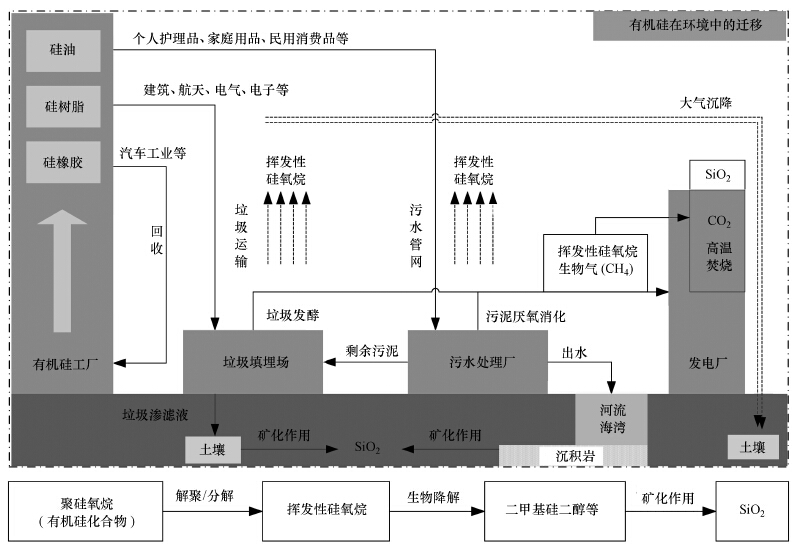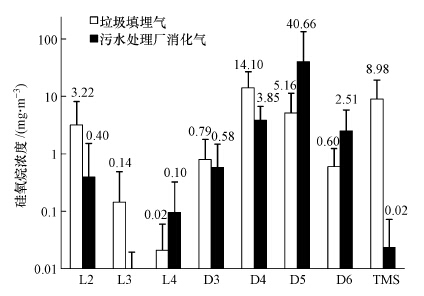2. 美国斯坦福大学土木与环境工程系, 科第伽资源回收研究中心 Stanford, CA94305, USA;
3. 上海交通大学环境科学与工程学院, 上海 200240;
4. 北京国环清华环境工程设计研究院有限公司, 北京 100084
2. Department of Civil & Environmental Engineering, William & Cloy Codiga Energy Recovery Research Center, Stanford University, Stanford, CA 94305, USA;
3. School of Environmental Science and Engineering, Shanghai Jiao Tong University, Shanghai 200240;
4. Guohuan Tsinghua Environment Engineering Design & Research Institute Co., Ltd., Beijing 100084
硅是自然界中存在最为广泛的元素之一,通常以复杂的硅酸盐或二氧化硅的形式存在于岩石、砂砾、尘土之中.聚硅氧烷(Poly-dimethylsiloxanes,PDMS)是重要的有机硅材料,由于其优异的性能,在人类生活中有着非常广泛的应用,如硅油用于纺织品、个人护理品等(Lu et al., 2011),硅树脂用于防水剂、电子电气及涂料及塑料等(Homrighausen and Keller, 2002),以及硅橡胶用于建筑和汽车零部件等.2012年全球有机硅市场已达147 亿美元(周勤等,2013).近年来,我国已经成为全球有机硅市场发展最快的国家之一.截至2012年底,我国已有15 家生产有机硅单体的企业,合计年产能2035 kt,其中2012年实际产量约1340 kt(杨晓勇,2013).近年来发现,大量使用有机硅材料的潜在的环境问题是聚硅氧烷在环境中迁移和转化为小分子硅氧烷(Brooke et al., 2009a;2009b;2009c),有可能危害人类健康安全(Chainet et al., 2011;Xu et al., 2012).
从聚硅氧烷形成硅氧烷的主要问题是影响利用生物气的利用.生物气是一种可再生能源,主要成分为甲烷.目前利用的生物气主要来源于垃圾填埋场、有机废物厌氧消化器和污水处理厂的消化气.国外近十年来的研究发现,生物气中硅氧烷含量越来越高(Läntelä et al., 2012;Piechota et al., 2013),其浓度可达0.2~400 mg · m-3(Rasi et al., 2011).用生物气发电时,硅氧烷会与氧气燃烧生成细小的二氧化硅晶体会在内燃机内壁或燃气轮机的页轮表面累积形成二氧化硅层,其反应过程如下所示:
形成的二氧化硅层会大幅缩短内热机的使用寿命,使维护运行成本增加(袁红姝等,2009).另外,利用生物气作锅炉燃料时,硅氧烷也会在炉管壁上形成二氧化硅层,降低能源效率.因此,在利用生物气作燃料之前,必须将硅氧烷去除.
近十年来,国际上对硅氧烷已有了相当的研究,开发了从生物气中清除硅氧烷的工艺.国内对此刚刚起步.本文将综述迄今为止国际上对硅氧烷在环境中的迁移转化的研究成果,以城市废水处理和垃圾填埋场为重点,结合硅氧烷的物理化学性质,分析硅氧烷在废水、污泥和生物气中的迁移转化和浓度分布,探讨了生物降解硅氧烷的可行性和评价从生物气中清除硅氧烷的工艺.
2 硅氧烷的理化性质(Physical-chemical properties of siloxanes)硅氧烷是一类由Si—O—Si键构成主链结构的含硅有机物.在垃圾填埋场气和污水处理厂消化气中常见的硅氧烷包括环状硅氧烷(D3~D6)、链状硅氧烷(L2~L5)和三甲基硅醇(TMS),它们的理化性质和分子结构分别如图 1和表 1所示.这些硅氧烷相对分子量均小于450,沸点在99 ℃以上.其中饱和蒸汽压常数最大的是L2,最小的是L5,因此硅氧烷L2的挥发性最强.环境风险评估表明,D4和D5具有生物毒性(Brooke et al., 2009a,2009b),而D6没有达到持久性、生物累积性和有毒物质的标准(Brooke et al., 2009c).除TMS以外,其他硅氧烷在水中的溶解度均很低.目前在中、美、欧等国的饮用水卫生标准中均未涉及检测硅氧烷.硅氧烷的分子结构特点使之容易与甲烷等碳氢化合物结合,从而进入生物气中.
 |
| 图 1 硅氧烷的分子结构式(资料来源:Bletsou et al., 2013) Fig. 1 Molecular structures of siloxanes |
| 表 1 生物气中常见的硅氧烷的理化性质 Table 1 Physical-chemical properties of siloxanes in biogas |
常用有机硅产品的废弃物是环境中硅氧烷的主要来源(图 2).随着国内城市化水平的提高,来自有机硅废弃物的硅氧烷进入环境的主要途径有:有机硅废液经污水管道管网进入污水处理厂污水及脱水污泥(Liu et al., 2014),有机硅固体废弃物经垃圾收集途径进入垃圾填埋场,未被人工系统收集的废弃有机硅会逐渐沉积到自然环境之中.有文献报道,在环境土壤(Wang et al., 2013)、河流底泥(Zhang et al., 2011)以及海湾(Whelan and Breivik, 2013)均发现了硅氧烷的积累.目前,仅有很小一部分有机硅产品如轮胎制品在使用废弃后会被回收得到有效处理(Dufresne,2007).
 |
| 图 2 硅氧烷在环境中的迁移转化途径 Fig. 2 Migration and transformation of siloxanes in environment |
环境中,厌氧产甲烷、硫酸还原、硝酸盐还原、 好氧代谢等微生物化学过程均可能使聚硅氧烷发生解聚/分解反应,转化为挥发能力较强的小分子硅氧烷(Warner et al., 2010;McLachlan et al., 2010;Cheng et al., 2011).这些小分子挥发性硅氧烷可以进一步被生物降解,形成中间水解产物,一般为二甲基烷醇(Dimethylsilanediol,DMSD).有人发现,用土壤处理上百天之后,二甲基烷醇可以被进一步生物降解(Lehmann et al., 1998a),矿化成SiO2、CO2和H2O(Griessbach and Lehmann, 1999).
生物气中硅氧烷源于污水处理厂的废水和垃圾填埋场的废弃物中的有机硅成分.研究硅氧烷在污水处理厂和垃圾填埋场的迁移转化规律可为降低生物气中硅氧烷浓度提供控制对策.目前,在污水处理厂进水中发现的硅氧烷种类比生物气中报道的硅氧烷种类多,有D3~D7和L4~L14(Bletsou et al., 2013;Xu et al., 2013),其中主要成分为D5~D6和L7~L12.Bletsou 等(2013)分析了希腊某污水处理厂的硅氧烷迁移转化过程,结果表明污泥中存留硅氧烷占进水硅氧烷总量的68%,其余的硅氧烷主要通过处理水排出污水处理厂.污水处理过程中,总挥发硅氧烷量很低,在构筑物空气环境中主要存在环状(D3~D5)硅氧烷,含量远高于链状硅氧烷(L3~L5)(Cheng et al., 2011),可能与污水处理过程中微生物对不同硅氧烷的分解作用有关.Bletsou等(2013)的研究表明,通过污水处理厂处理,L8总量可以下降20%,但同时D5、L5~L7等总量却提高40%.Xu等(2013)研究污水处理工艺中不同阶段对硅氧烷去除效果,结果表明,厌氧池是去除D3~D6的主要工艺阶段.以上研究表明,污泥吸附和污水处理工艺条件是影响污水处理厂硅氧烷迁移转化的重要因素.但是,污水处理过程中硅氧烷的转化途径与相应的微生物代谢机理尚未有详细的研究报道.另外,目前也尚未有人报道关于垃圾填埋场中硅氧烷的迁移转化规律研究成果.
4 硅氧烷的可生物降解性(Biodegradability of siloxanes)Accettola等(2008)用生物滴滤池处理含45~77 mg · m-3 D3~D4的生物气,结果表明D3~D4去除率约为10%~20%.Popat和Deshusses(2008)的研究表明,用生物滴滤池处理含D4(45 mg · m-3)的生物气,在好氧条件下D4去除率随气体停留时间增长而提高,在气体停留时间19.5 min时,获得的最大D4去除率为43%;在厌氧条件下,虽然微生物利用硝酸盐或硫酸盐作为电子受体也可以去除硅氧烷,但去除效率较好氧条件要低一些.Xu等(2013)在厌氧条件用活性污泥处理硅氧烷,经过60 h后,D3、D4、D5和D6的去除率分别为3.0%、44.4%、62.8%和18.1%.以上研究表明,硅氧烷可以被微生物降解,但生物降解硅氧烷的效率很低.Popat和Deshusses(2008)认为由于硅氧烷在水中的溶解度很低,使得硅氧烷与生物细胞表面或细胞膜之间存在较高的传质阻力是硅氧烷生物降解速率较低的主要原因.因而可以考虑通过添加某些有机溶剂来提高硅氧烷与水相之间的传质效率,从而提高硅氧烷的去除效率.Accettola 等(2008)发现属于假单胞菌(Pseudomonas)的一株细菌基因可以利用D4作为碳源进行生长,认为通过分离具有降解硅氧烷能力的微生物作培养物,有可能会获得更高的硅氧烷去除效果.在用活性污泥法、生物滤池等进行生物降解的处理过程中,微生物转化二甲基烷醇为CO2的速率非常缓慢,因此硅氧烷降解的产物一般累集为二甲基烷醇(Grümping et al., 1999;Accettola et al., 2008).但在土壤环境中,也确实存在降解二甲基烷醇的微生物(Lehmann et al., 1998b),如Arthrobacter sp.细菌和Fusarium oxysporum真菌(Sabourin et al., 1996).迄今为止,对硅氧烷的降解无论在机理、代谢途径和微生物学方面,都非常肤浅,更没有深入在蛋白与分子生物学领域.目前我国尚未有关于硅氧烷生物降解的报道.
5 生物气中硅氧烷的浓度分布(Profile of siloxanes concentration in biogas)Rasi 等(2011)统计分析了芬兰、德国、加拿大等国家的垃圾填埋场气和污水处理厂消化气中有机硅浓度,浓度范围分别为0.2~35.8 mg · m-3和0.4~59.8 mg · m-3,少数污水处理厂的消化气中有机硅浓度最大可达400 mg · m-3.我们统计分析了世界各国已发表报道的垃圾填埋场气和污水处理厂消化气中不同种类的硅氧烷(如L2~L4、D3~D6和TMS)的浓度及其分布情况,结果分别见表 2和图 3.可以看出,在垃圾填埋场气中D4的浓度较高,可达(37.6±1.7)mg · m-3;而在污水处理厂消化气中D5浓度较高,可达(340.7±0.09)mg · m-3.总体上来说,污水处理厂消化气中硅氧烷浓度通常比垃圾填埋场气高.这有可能与污水处理厂消化池温度较高,有利于硅氧烷的挥发有关.比较垃圾填埋场气和污水处理厂消化气中硅氧烷的浓度分布,结果表明垃圾场填埋气中硅氧烷主要成分是L2、D4、D5和TMS,依含量高低排序为D4>TMS>D5>L2.而在污水处理厂消化气中硅氧烷主要成分是D4、D5和D6,依含量高低排序为D5>D4>D6.这两种含硅氧烷的生物气共同点是D4和D5的浓度较高,不同点是在垃圾填埋场气中存在较高浓度的L2、L3和TMS.这两种生物气中的硅氧烷浓度分布具有一定差异,因而对应的去除硅氧烷的技术需求也应当有所差别.产生硅氧烷浓度分布差异的原因可能与产甲烷反应环境条件和微生物代谢差异有关.
 |
| 图 3 垃圾填埋场气和污水处理厂消化气中硅氧烷浓度分布比较 注: Piechota et al., 2013; Läntelä et al., 2012; Clark et al., 2012; Ajhar et al., 2010b; Urban et al., 2009; Lens et al,2005; Schweigkofler and Niessner, 2001; Schweigkofler and Niessner, 1999; Piechota et al., 2013; Mariné et al., 2012; Khandaker and Seto, 2010; Urban et al., 2009; Schweigkofler and Niessner, 2001; Schweigkofler and Niessner, 1999 Fig. 3 Comparison of distribution of siloxanes concentrations in biogas from l and fill and digesters |
迄今为止,我国尚未有人调查研究硅氧烷在消化气中的含量和分布.这可能与目前我国的消化气利用率低有关.现在,回收废水废弃物中的能源和资源已成为环境业界的共识.在今后若干年,利用生物气必然大有前途.因此,弄清硅氧烷在我国不同来源的生物气中的分布现状与趋势是有效利用生物气所必不可少的一步.
6 生物气中硅氧烷去除工艺(Removal of siloxanes from biogas)近年来,垃圾填场气和污水处理厂消化气中的硅氧烷浓度呈逐年上升趋势.这与近年来有机硅制品的使用量大幅增多有关.在许多生物气中,有机硅浓度常高于内燃机发电的进气要求(≤15 mg · m-3).因此在利用生物气之前,必须去除生物气中的有机硅.目前,国外商业化应用的从生物气中去除有机硅技术有吸附工艺和吸收工艺与低温冷凝藕联工艺(Ajhar et al., 2010a).许海朋等(2012)对此已有比较详细的论述.去除生物气中硅氧烷应用最为广泛的技术是吸附工艺,包含固定床和流化床两种.其中固定床吸附工艺采用可再生吸附剂,如活性炭、活性炭与石墨混合剂、以及氢氧化铁等;流化床吸附技术通过连续吸附再生去除硅氧烷,适合含硅氧烷浓度较高的生物气处理.低温冷凝技术是用零下23~25 ℃以下的温度控制去除部分硅氧烷.Schweigkofler和Niessner(2001)通过技术比较分析,认为低温冷凝技术对硅氧烷的去除效果不及吸附工艺,并且由于低温过程实质上并不去除硅氧烷,使得清洗冷凝器中残留的硅氧烷又变得十分困难(Soreanu et al., 2011).膜分离法是近年来研究者关注的一项新型技术,通过高聚合膜有选择性地分离硅氧烷和甲烷来实现硅氧烷去除(Basu et al., 2010).Ajhar等(2012)测试了商业化的PDMS膜对生物气中硅氧烷的去除情况,发现膜分离会造成近7%左右的甲烷损失.目前,纯化生物气的商业化技术包括吸附、吸收和低温冷凝等,总体上还存在处理费用较高的问题,膜分离等新型处理技术距规模化应用与经济性评估也还有待进一步研究.随着大量开发和利用生物气回收能源,开发适合中国特点的硅氧烷去除工艺将是生物气利用工艺设计和运行的一项重要环节.
7 研究与展望(Research and future outlook)
随着国内外近年来有机硅产品消费规模快速增加,环境中硅氧烷的释放水平将大幅提高,垃圾填埋场气和污水处理厂消化气硅氧烷浓度也将逐年升高.废水和固体废弃物收集系统是硅氧烷进入环境和生物气的主要途径.今后应考虑,在人工收集系统期对有机硅加强源头控制,这可能是降低生物气中硅氧烷浓度的有效手段.在机理研究方面,需要进一步研究各类常用有机硅产品在环境中的迁移转化,进而对易在环境中产生硅氧烷的有机硅产品在源头进行分类回收提供基础.目前对硅氧烷的降解,在微生物学、生物化学和分子生物学的研究很少或基本是空白,今后的研究应集中在降解硅氧烷的功能菌和功能基因,从而发展高效,适用的处理工艺和改进有机硅产品.
| [1] | Accettola F, Guebitz G M, Schoeftner R. 2008. Siloxane removal from biogas by biofiltration:biodegradation studies[J]. Clean Technologies and Environmental Policy, 10(2):211-218 |
| [2] | Ajhar M, Travesset M, Yüce S, et al. 2010a. Siloxane removal from landfill and digester gas-A technology overview[J]. Bioresource Technology, 101(9):2913-2923 |
| [3] | Ajhar M, Wens B, Stollenwerk K H, et al. 2010b. Suitability of Tedlar® gas sampling bags for siloxane quantification in landfill gas[J]. Talanta, 82(1):92-98 |
| [4] | Ajhar M, Bannwarth S, Stollenwerk K H, et al. 2012. Siloxane removal using silicone-rubber membranes[J]. Separation and Purification Technology, 89:234-244 |
| [5] | Arnold M, Kajolinna T. 2010. Development of on-line measurement techniques for siloxanes and other trace compounds in biogas[J]. Waste Management, 30(6):1011-1017 |
| [6] | Basu S, Khan A L, Cano-Odena A, et al. 2010. Membrane-based technologies for biogas separations[J]. Chemical Society Reviews, 39(2):750-768 |
| [7] | Bletsou A A, Asimakopoulos A G, Stasinakis A S, et al. 2013. Mass loading and fate of linear and cyclic siloxanes in a wastewater treatment plant in Greece[J]. Environmental Science & Technology, 47(4):1824-1832 |
| [8] | Brooke D N, Crookes M J, Gray D, et al. 2009a. Environmental Risk Assessment Report:Decamethylcyclopentasiloxane[M]. Bristol:Environment Agency of England and Wales |
| [9] | Brooke D N, Crookes M J, Gray D, et al. 2009b. Environmental Risk Assessment Report:Octamethylcyclotetrasiloxane[M]. Bristol:Environment Agency of England and Wales |
| [10] | Brooke D N, Crookes M J, Gray D, et al. 2009c. Environmental Risk Assessment Report:Dodecamethylcyclohexasiloxane[M]. Bristol:Environment Agency of England and Wales |
| [11] | Chainet F, Lienemann C P, Courtiade M, et al. 2011. Silicon speciation by hyphenated techniques for environmental, biological and industrial issues:a review[J]. Journal of Analytical Atomic Spectrometry, 26(1):30-51 |
| [12] | Cheng Y, Shoeib M, Ahrens L, et al. 2011. Wastewater treatment plants and landfills emit volatile methyl siloxanes (VMSs) to the atmosphere:Investigations using a new passive air sampler[J]. Environmental Pollution, 159(10):2380-2386 |
| [13] | Clark C, Zytner R G, McBean E. 2012. Analyzing volatile organic siloxanes in landfill biogas[J]. Canadian Journal of Civil Engineering, 39(6):667-673 |
| [14] | Dufresne P. 2007. Hydroprocessing catalysts regeneration and recycling[J]. Applied Catalysis A:General, 322:67-75 |
| [15] | Griessbach E F C, Lehmann R G. 1999. Degradation of polydimethylsiloxane fluids in the environment-a review[J]. Chemosphere, 38(6):1461-1468 |
| [16] | Grümping R, Michalke K, Hirner A V, et al. 1999. Microbial degradation of octamethylcyclotetrasiloxane[J]. Applied and Environmental Microbiology, 65(5):2276-2278 |
| [17] | Homrighausen C L, Keller T M. 2002. Synthesis and characterization of a silarylene-siloxane-diacetylene polymer and its conversion to a thermosetting plastic[J]. Polymer, 43(9):2619-2623 |
| [18] | Khandaker N, Seto P. 2010. Novel application of vermiculite for siloxane removal from biogas[J]. International Journal of Green Energy, 7(1):38-42 |
| [19] | Läntelä J, Rasi S, Lehtinen J, et al. 2012. Landfill gas upgrading with pilot-scale water scrubber:Performance assessment with absorption water recycling[J]. Applied Energy, 92:307-314 |
| [20] | Lehmann R G, Miller J R, Xu S, et al. 1998a. Degradation of silicone polymer at different soil moistures[J]. Environmental Science & Technology, 32(9):1260-1264 |
| [21] | Lehmann R G, Miller J R, Collins H P. 1998b. Microbial degradation of dimethylsilanediol in soil[J]. Water, Air, and Soil Pollution, 106(1/2):111-122 |
| [22] | Lens P, Westermann P, Habenbauer M. 2005. Biofuels for fuel cells:renewable energy from biomass fermentation[M]. New York:IWA Publishing |
| [23] | Liu N N, Shi Y L, Li W H, et al. 2014. Concentrations and distribution of synthetic musks and siloxanes in sewage sludge of wastewater treatment plants in China[J]. Science of the Total Environment, 476-477:65-72 |
| [24] | Lu Y, Yuan T, Wang W H, et al. 2011. Concentrations and assessment of exposure to siloxanes and synthetic musks in personal care products from China[J]. Environmental Pollution, 159(12):3522-3528 |
| [25] | Mariné S, Pedrouzo M, Maria Marcé R, et al. 2012. Comparison between sampling and analytical methods in characterization of pollutants in biogas[J]. Talanta, 100:145-152 |
| [26] | McLachlan M S, Kierkegaard A, Hansen K M, et al. 2010. Concentrations and fate of Decamethylcyclopentasiloxane (D5) in the atmosphere[J]. Environmental Science & Technology, 44(14):5365-5370 |
| [27] | Piechota G, Igliński B, Buczkowski R. 2013. Development of measurement techniques for determination main and hazardous components in biogas utilised for energy purposes[J]. Energy Conversion and Management, 68:219-226 |
| [28] | Popat S C, Deshusses M A. 2008. Biological removal of siloxanes from landfill and digester gases:opportunities and challenges[J]. Environmental Science & Technology, 42(22):8510-8515 |
| [29] | Rasi S, Läntelä J, Rintala J. 2011. Trace compounds affecting biogas energy utilisation-A review[J]. Energy Conversion and Management, 52(12):3369-3375 |
| [30] | Sabourin C L, Carpenter J C, Leib T K, et al. 1996. Biodegradation of dimethylsilanediol in soils[J]. Applied and Environmental Microbiology, 62(12):4352-4360 |
| [31] | Schweigkofler M, Niessner R. 1999. Determination of siloxanes and VOC in landfill gas and sewage gas by canister sampling and GC-MS/AES analysis[J]. Environmental Science & Technology, 33(20):3680-3685. |
| [32] | Schweigkofler M, Niessner R. 2001. Removal of siloxanes in biogases[J]. Journal of Hazardous Materials, 83(3):183-196 |
| [33] | Soreanu G, Béland M, Falletta P, et al. 2011. Approaches concerning siloxane removal from biogas-A review[J]. Canadian Biosystems Engineering, 53(8):1-18 |
| [34] | Urban W, Lohmann H, Salazar Gómez J I. 2009. Catalytically upgraded landfill gas as a cost-effective alternative for fuel cells[J]. Journal of Power Sources, 193(1):359-366 |
| [35] | Wang D G, Steer H, Tait T, et al. 2013. Concentrations of cyclic volatile methylsiloxanes in biosolid amended soil, influent, effluent, receiving water, and sediment of wastewater treatment plants in Canada[J]. Chemosphere, 93(5):766-773 |
| [36] | Warner N A, Evenset A, Christensen G, et al. 2010. Volatile siloxanes in the European Arctic:assessment of sources and spatial distribution[J]. Environmental Science & Technology, 44(19):7705-7710 |
| [37] | Whelan M J, Breivik K. 2013. Dynamic modelling of aquatic exposure and pelagic food chain transfer of cyclic volatile methyl siloxanes in the Inner Oslofjord[J]. Chemosphere, 93(5):794-804 |
| [38] | Xu L, Shi Y L, Wang T, et al. 2012. Methyl siloxanes in environmental matrices around a siloxane production facility, and their distribution and elimination in plasma of exposed population[J]. Environmental Science & Technology, 46(21):11718-11726 |
| [39] | Xu L, Shi Y L, Cai Y Q. 2013. Occurrence and fate of volatile siloxanes in a municipal Wastewater Treatment Plant of Beijing, China[J]. Water Research, 47(2):715-724 |
| [40] | 许海朋, 张晓东, 金付强, 等. 2012. 沼气中硅氧烷去除技术研究进展[J]. 中国沼气, 30(6):18-22 |
| [41] | 杨晓勇. 2013. 2012 年中国有机硅行业运行情况及未来展望[J]. 有机硅材料, 27(2):71-75 |
| [42] | 袁红姝, Gehring M J, 杨天华. 2009. 挥发性和半挥发性硅氧烷在生物气中的迁移转化规律及脱除方法[J]. 可再生能源, 27(4):51-54 |
| [43] | Zhang Z F, Qi H, Ren N Q, et al. 2011. Survey of cyclic and linear siloxanes in sediment from the Songhua River and in sewage sludge from wastewater treatment plants, Northeastern China[J]. Archives of Environmental Contamination and Toxicology, 60(2):204-211 |
| [44] | 周勤, 张爱霞, 曾向宏. 2013. 2012 年国外有机硅进展[J]. 有机硅材料, 27(4):286-306 |
 2015, Vol. 35
2015, Vol. 35


 , 迟莉娜3, 汪诚文1, 4
, 迟莉娜3, 汪诚文1, 4